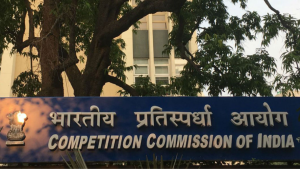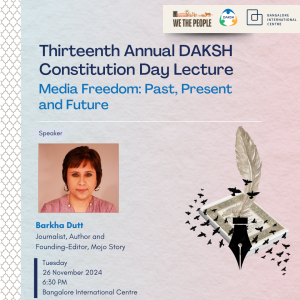

Open courts
- Anindita
- /
- The DAKSH Podcast /
- Open Courts
Show Notes
-
Support us by Donating.
-
Chitranshul Sinha, The Great Repression India, Viking 2019
-
IshitaPande, “Phulmoni’s body: the autopsy, the inquest and the humanitarian narrative on child rape in India.” South Asian History and Culture 4.1 (2013): 9-30.
-
Queen-Empress vs Hurree Mohun Mythee (1891) ILR 18 Cal 49 https://indiankanoon.org/doc/1410526/
Hi, I’m Anindita and welcome to the DAKSH podcast. Have you ever wondered what the inside of a courtroom looks like?
For most people attending a court proceeding is usually a rare event. A lot of the time the events that lead to getting involved in a case are traumatic after that being a participant in the court process itself is also a difficult experience. But what have you had the chance to be a fly on the wall and just observe case proceedings? Today, we are going to help you understand the open court principle. It means that we should have easy access to information about what courts do.
Our country follows the Open Courts principle. Traditionally, this has meant mainly two things. One, court proceedings, including documents disclosed in those proceedings should be open to public scrutiny and to judges should give their decisions in public. Why is this important? There are many reasons. It is both the right to the litigants, that is the people involved in the case and the right of the public. The first as the right of the litigants, this principle protects the people involved in court cases. public scrutiny usually puts authorities on guard judges are less likely to display bias, make mistakes, or give conflicting decisions if they are being observed. This ensures that ordinary people have a fighting chance of getting a fair hearing as the right of the public. Open Courts are a great way for citizens to know the law and understand its application. The justice system belongs to all of us, not just lawyers and governments. By making court proceedings transparent, we understand what the law is, and we are better able to demand the changes we want. This is essential in a democracy like ours. The Open Courts principle has another ancient but relevant foundational reason. A public trial has long since served as a therapeutic outlet for community concern and emotion, especially in criminal cases. A public sentence tells everyone that justice is indeed being done. And it helps people trust the judiciary. Every time a heinous criminal, a crooked businessman, or a corrupt government is quote unquote, brought to justice. We know the justice system is working. And we’re less likely to take the law into our own hands.
Now that we know that India is supposed to follow the open court principle, and why it’s relevant, let’s move on to how much a courts actually adhere to it. We can start with the most basic understanding of the principle by seeing courtrooms as physical spaces that are open to the public. Can you just walk into an Indian court claiming that we have open courts in this country? Theoretically, yes, most courts are open courts, literally.
You may feel like a fish out of water but you can very much walk into your local city civil court or district court and observe their proceedings. In fact, I highly recommend you try it. It puts all those legal dramas in perspective. In a practical sense, however, there are some restrictions in some courts. due to security risks and constraints of space. The Supreme Court requires members of the public to obtain a permit to enter their courtrooms. To get a permit you need a photograph a signature from an advocate, government issued identification and the court number you wish to visit. similar processes exist in most high courts and some busy or crime prone city courts. On the plus side. Some courts host tours on weekends. Check them out. Welcome to the Indian Supreme Court. I’m your tour guide. No no no, don’t touch the gavel.
But the principle of Open Courts goes far beyond me of Physical access for the public to truly understand court processes. Courts have to make these documents public and take some steps to ensure that the public can actually understand what’s happening. For example, one of the main rules that judges are bound to follow is the provision of a reasoned order. A judge cannot simply declare a person guilty or innocent in a criminal case, or just deny your grand property in an inheritance case, without setting out clear reasons for the decision. These reasons are important for the public to understand the judicial logic that led to that conclusion. Judicial reasoning is also a step in the court process, and is thus a part of Open Courts. decisions without adequate reasoning, even if they were correct, can be struck down. That’s how powerful transparency is to ensure a fair proceeding.
Well, this means written records of our court proceedings should be easily accessible to the public, right? Not really. Most judgments of the Supreme Court and high courts are made available on their websites. And all the judgments of these courts are now being digitized. But the actual record of arguments made by the parties, and document evidence in these cases are not as easily available. Typically, you can request these documents if you were a party to the case, but you’re more likely to get these records from lawyers involved rather than the court itself. The most talked about and visible application of the open court principle is media access to courts. Journalists can freely enter courts on priority and write about court proceedings. But they are subject to some restrictions. They cannot publish defamatory material, or commit contempt of court. Contempt of court is a criminal offence committed when someone publishes material that lowers the authority of a court or interferes with justice. Sometimes news media reports have been found to be in contempt of court. We can save that discussion for later. For now, here’s some food for thought. is the duty of Open Courts limited to judges? Or does it extend to the media for the open court principle to truly work? That is for the public to actually understand legal proceedings, the media should report it accurately. And in a simple way, when the media distorts facts, or doesn’t present the entire story, the principle of Open Courts loses its meaning. Okay, so we have some applications of the principle covered. But with the growth of technology, the purpose of Open Courts can be served in many new ways that are still being debated. Let’s take the example of live streaming court proceedings. In principle, if anyone can walk into court, should they not be able to watch a broadcast of it to parliament’s proceedings are publicly broadcasted? So why shouldn’t court proceedings be? The answer isn’t quite as simple. There is a case for this in matters concerning larger public interest, which rarely involve particular details of individual citizens. But instance the challenge to repealing the special status of Kashmir or the challenge to the validity of sedition law. But in many other cases, personal details about individuals are exposed in court and broadcasting it to a wide audience raises concerns of privacy. Even in a physical sense. Some parts of cases like witness testimonies of rape survivors, and discussions on trade secrets are held in private. Only lawyers and litigants are allowed in the courtroom then. But there are many other cases like property disputes amongst families, adoption cases, and defamation trials that are held in open court, but may not be entirely suitable for public broadcast. Nonetheless, six high courts are currently live streaming their proceedings. These are the high courts at Gujarat, Jharkhand, Patna, Karnataka, Madhya Pradesh and Odessa. Yet there are still fears about what should be live streamed, how it can be republished, and if YouTubers can end up making an Indian Judge Judy, with repurposed live streaming clips. And remember, put out content that people want. A second emerging ask is an easily accessible, searchable, open database of judgments. Right now, you can access a judgment if you already know the case, number, the adjudicating authority are the data, the judgment, or sometimes all three. And even if you did know all this, it often requires a complicated set of search acrobatics and different court websites. Lawyers usually pay for sophisticated search and case management applications to allow them to track and search cases comprehensively. But ideally, we shouldn’t have to pay for this. easy and affordable access to case information is a right of the public under the open code principle. Another important implication of the open code principle is the publication of clear, accurate and usable case statistics. This helps researchers and analysts get a true sense of how well the judicial system functions and where existing bottlenecks are. Finally, enough, aggregated data allows judges themselves to see what is happening in the judicial system from a perspective they didn’t have before. After all, judges are citizens to and they have a right to know. Despite this case, statistics are meager and difficult to download for nuanced analysis.
Stay tuned to the DAKSH podcast to learn how machine learning has an impact on the open court principle. If you have any other ideas on how technology can further the Open Courts principle, write to us at info@DakshIndiaorg or comment on our social media pages. If you’re interested in our work on any of these applications of the principle, like the role of the media and justice, live streaming of court proceedings, open database of judgments or data visibility, check out the show notes. A special thanks to our interns Bhavya Sudhir and Bhumika Urs for helping out with the research for this episode. If you enjoyed the episode, do consider supporting us with a donation. The link is in the show notes below. Creating this podcast takes effort and Your support will help us sustain a space for these quality conversations. To find out more about us and our work, visit our website Dakshindia.org. That’s D A K S H India dot ORG don’t forget to tap follow or subscribe to us wherever you listen to your podcasts so that you don’t miss an episode. We would love to hear from you. So do share your feedback either by dropping us a review or rating the podcast by podcast apps allow you to talk about it on social media. We’re using the hashtag DAKSH podcast, which really helps get the word out there. Most of all, if you found something useful that might help a friend or family member share the episode with them. A special thanks to our production team at made in India our production head Nikitina K edited mixed and mastered by Lakshman Parashuram and project supervision by Sean Fanthorpe.
RECENT UPDATE


Thirteenth Annual DAKSH Constitution Day Lecture

Not Quite Rocket Science

Administration of justice needs an Aspirational Gatishakti

-
Rule of Law ProjectRule of Law Project
-
Access to Justice SurveyAccess to Justice Survey
-
BlogBlog
-
Contact UsContact Us
-
Statistics and ReportsStatistics and Reports
© 2021 DAKSH India. All rights reserved
Powered by Oy Media Solutions
Designed by GGWP Design